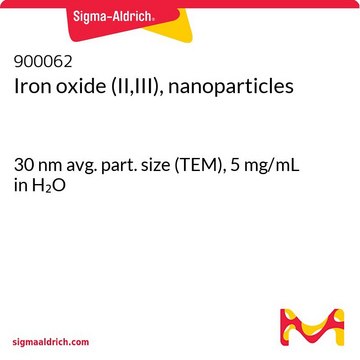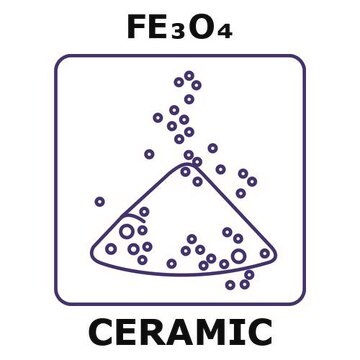Key Documents
720712
Iron(III) oxide, dispersion
nanoparticles, ≤110 nm particle size, 15 wt. % in ethanol
Synonim(y):
Iron oxide in ethanol
About This Item
Polecane produkty
Postać
nanoparticles
Poziom jakości
stężenie
15 wt. % in ethanol
wielkość cząstki
≤110 nm
ciąg SMILES
O=[Fe]O[Fe]=O
InChI
1S/2Fe.3O
Klucz InChI
JEIPFZHSYJVQDO-UHFFFAOYSA-N
Szukasz podobnych produktów? Odwiedź Przewodnik dotyczący porównywania produktów
Hasło ostrzegawcze
Danger
Zwroty wskazujące rodzaj zagrożenia
Zwroty wskazujące środki ostrożności
Klasyfikacja zagrożeń
Eye Dam. 1 - Flam. Liq. 2
Kod klasy składowania
3 - Flammable liquids
Klasa zagrożenia wodnego (WGK)
WGK 1
Wybierz jedną z najnowszych wersji:
Masz już ten produkt?
Dokumenty związane z niedawno zakupionymi produktami zostały zamieszczone w Bibliotece dokumentów.
Klienci oglądali również te produkty
Produkty
Professor Hui Mao explores the use of superparamagnetic iron oxide nanoparticles (INOPs) that offer an alternate contrast-enhancing mechanism.
Prof. Yadong Yin omawia różne metody syntezy nanokryształów magnetytu i ich zastosowania w różnych dziedzinach.
Professor Yadong Yin (University of California Riverside, USA) examines both direct (thermal decomposition, solvothermal, hydrothermal) and indirect (templated) synthesis methods of magnetite nanocrystals and reviews in detail the landscape of these various synthetic methods for magnetite nanocrystal and their applications in magnetic assembly, magnetic hyperthermia, and Li-Ion batteries.
The application of magnetism and magnetic materials pervades our modern civilization in the form of electrical power, communications and information storage.
Nasz zespół naukowców ma doświadczenie we wszystkich obszarach badań, w tym w naukach przyrodniczych, materiałoznawstwie, syntezie chemicznej, chromatografii, analityce i wielu innych dziedzinach.
Skontaktuj się z zespołem ds. pomocy technicznej




